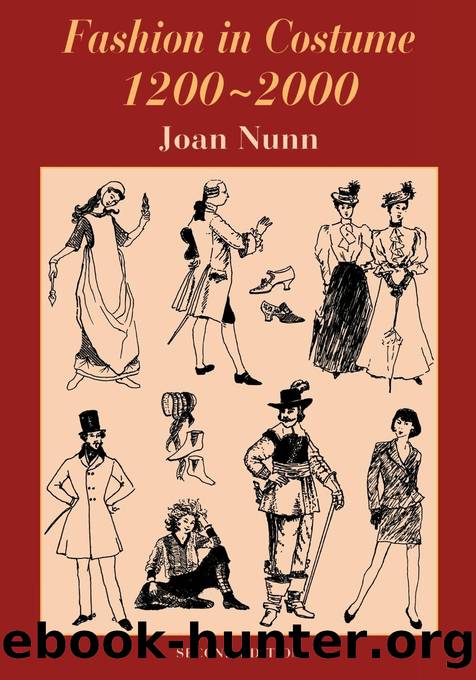Fashion in Costume 1200-2000 by Joan Nunn

Author:Joan Nunn
Language: eng
Format: epub
Publisher: New Amsterdam Books
Published: 2000-01-15T00:00:00+00:00
From 1896 the size of the sleeve decreased and the next fashion cycle began to take shape, heralding the S-bend typical of the early 1900s; with the bosom appearing fuller and lower, an exaggerated fullness was gathered at the front of the bodice overhanging the straightened front of the skirt.
Womenâs hair styles tended to reflect the lines of their gowns. As skirts were drawn back in the mid to late 1860s, so the hair was also drawn up and back to reveal the ears, for so long covered, but kept flat on top, with curls or a small twist at the back of the head reflecting the back interest on the dress. With the first bustles in the early 1870s the hair was lifted higher, sloping upward from forehead to occiput, then cascading to the shoulders in lavish twisted plaits (braids) or curls, or both, or occasionally worn in a chignon. During this period enormous quantities of false hair were used by the very fashionable, obtained, in Catholic countries, from novices entering convents, and everywhere from prisoners or paupers in workhouses; hair might fetch a good price, and peasant girls in Germany, Italy and France whose traditional headdresses hid the absence of hair found its sale a source of income; even middle-class girls in England or America, in need of cash, might sell their hair, as Jo March did in Little Women.
In 1876 The Englishwomanâs Domestic Magazine announced that the use of false hair was a thing of the past; the slim straight line of the cuirass body was enhanced by hair dressed to give a smaller, neat appearance, close and high on the head. A few curls might be arranged to fall from the back of the head to the shoulders in the evening, and the increasingly fashionable, closely-curled fringe favoured by the Princess of Wales might often be false; a false fringe would avoid cutting the front hair. These fringes were thick enough to support a diamond clip in the shape of a star or crescent for evening. The small neat hairstyle remained in fashion through the late 1870s and into the 1880s, when the hair was scraped up into a bun on top of the head. The curled fringe was reduced to small tendrils on the forehead. By the 1890s it had disappeared altogether, and the hair was again dressed back from the forehead but fuller and softer, possibly over pads to give a more bouffant style, still with the twist or bun on top of the head.
Throughout the half century, bonnets and hats, apart from sporting styles, were lavishly trimmed, and hair was invariably decorated with flowers, jewels or feathers for evening. Indoor caps were gradually discontinued, by the 1870s worn only, perhaps, with a tea-gown or breakfast jacket and by elderly ladies; servants and country folk wore them well into the 20th century. The variety of millinery styles throughout this period was enormous, and it is only possible to indicate the main shapes, which were dictated by the hairstyles.
Download
This site does not store any files on its server. We only index and link to content provided by other sites. Please contact the content providers to delete copyright contents if any and email us, we'll remove relevant links or contents immediately.
How to Be a Bawse: A Guide to Conquering Life by Lilly Singh(6706)
Spare by Prince Harry The Duke of Sussex(4228)
Millionaire: The Philanderer, Gambler, and Duelist Who Invented Modern Finance by Janet Gleeson(3577)
Harry Potter 02 & The Chamber Of Secrets (Illustrated) by J.K. Rowling(3298)
Urban Outlaw by Magnus Walker(2953)
The Heroin Diaries by Nikki Sixx(2943)
Never by Ken Follett(2915)
Japanese Design by Patricia J. Graham(2564)
The Club by A.L. Brooks(2382)
Machine Learning at Scale with H2O by Gregory Keys | David Whiting(2324)
The Man Who Died Twice by Richard Osman(2313)
Stacked Decks by The Rotenberg Collection(2285)
Harry Potter and the Deathly Hallows (7) by J.K. Rowling(2238)
Fairy Tale by Stephen King(2101)
Will by Will Smith(2077)
Harry Potter and the Prisoner of Azkaban (Book 3) by J. K. Rowling(2073)
Churchill by Paul Johnson(2019)
The Chimp Paradox by Peters Dr Steve(1872)
The 7 Habits of Highly Effective People: Powerful Lessons in Personal Change (25th Anniversary Edition) by Covey Stephen R(1843)
